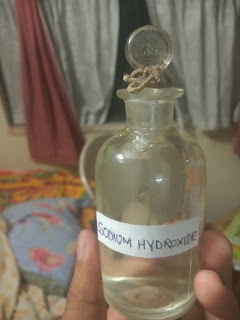Miniature representation of the Castner-Kellner process
Alkalis are an extremely important class of chemicals, be it for laboratory or industrial use. Usually they are bought from stores, however, in the event that you are unable to get some, you can always make it at home. This experiment deals with the production of sodium hydroxide solution at home, from the commonly used sodium chloride, or common salt.
The miniature setup of the Castner-Kellner process
The cup on the extreme right contains distilled water, while the others contain saturated sodium chloride solution. The cups are connected by cotton soaked in sodium chloride solution, which thus act as salt bridges. If you are performing this experiment, please note that on no account should the concentration of the penultimate cell on the right be less than that of those on its left. Similarly, the second cell from the left should not have a concentration lower than the one on its left.
For the electrolysis, I have used a 12V DC adaptor which originally used to power a set top box. The ends were cut off and the wires were exposed. For electrodes, I have used graphite rods from two AA batteries. Please note that on no account should the wires touch the solution, or each other. Only the graphite electrodes should remain in contact with the solution. The cathode was dipped into the beaker with distilled water, and the anode into the beaker adjacent to it, containing saturated sodium chloride solution.
The 12V DC adaptor used for the electrolysis
The purpose of setting up so many cells is to ensure that the process can proceed smoothly for quite some time without human intervention. The rightmost cell contains distilled water, and the one on its left contains saturated sodium chloride solution. The cells are connected by a salt bridge, which ensures a continuous flow of sodium ions into the rightmost cell due to the ionic gradient. This causes a drop in the concentration of the penultimate cell on the right, causing sodium ions from the second cell on the left to be drawn in. This chain continues, thus ensuring a proper supply of sodium ions, and making the rightmost cell almost saturated.
The purpose of using a salt bridge is to ensure appreciable purity of the sodium hydroxide formed, because if not used, the chlorine gas evolved would recombine with the formed sodium hydroxide to form sodium hypochlorite, thus defeating the purpose. In industrial practice, a Nafion membrane is used, which allows only selective ions to pass through.
A problem is that a lot of chlorine gas evolves at the anode, and although some of it dissolves in the water, most of it escapes, which might pose a health hazard if the room is not well ventilated. To counter this problem, I set up three plastic glasses full of hot saturated sodium carbonate solution, which could absorb the gas. I left the current on overnight, and in the morning, was rewarded with a highly concentrated sodium hydroxide solution, which accumulates at the cathode containing cell. At the cathode, hydrogen ions turn into hydrogen gas, and at the anode, chloride ion turn into chlorine gas.
Sodium hydroxide collecting at the cathode in a two cell Castner-Kellner process.
The sodium hydroxide solution thus produced.
The by products include chlorine water and sodium hypochlorite, which have turned the solution yellow in the second cell from the right in the first picture.
Please note that no metal objects should touch the surface of the solutions, as they may get corroded.
Kindly leave your valuable feedback in the comments. Thank you.







Comments
Post a Comment